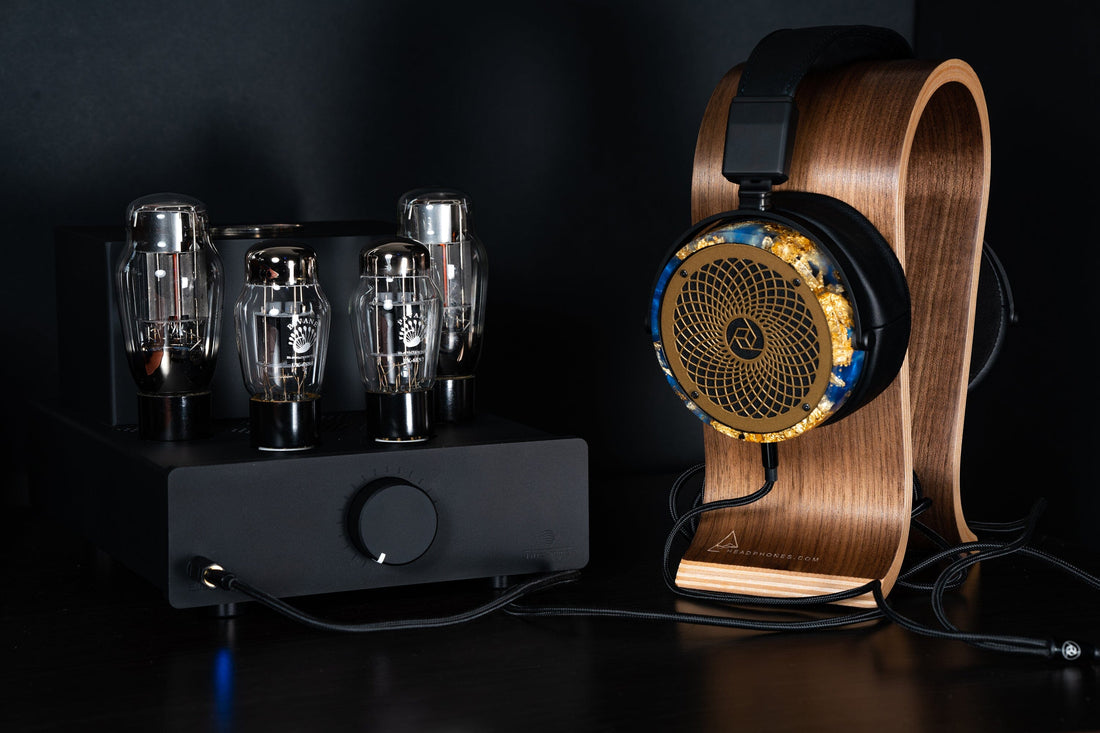The Most Popular Headphone Stand Might Be Ruining Your Headphones (Why Pads Matter)
The Omega headphone stand is the quintessential display piece. But did you know that it might be hurting the sound?

Aesthetics is a key pillar of many a hobby. Even in the audiophile world of listening, looks play a big part in the enjoyment of the musical experience. It's one reason for vinyl's revival - there's something ceremonial about placing a record on the platter and appreciating the slow spin of the turntable as music envelops you.
For headphones, the Omega stand is the quintessential display piece. The deep richness of wood and the beauty of its grain casts a fine contrast against the often utilitarian and industrial design of a headphone as it rests along the stand's gentle curves. It’s a visual harmony that makes transforms a mere headphone into being Instagram worthy.
But did you know that these beautiful stands might be ruining your headphones? Yes, that very sound signature you fell in love with changes the longer your headphones sit on these stands - and not always for the better. Let me tell you why.

Pad Flattening
The culprit is the flattening of the earpads against the walls of the Omega stand. This depends on many factors: the clamp force of your headphone, the depth of the pads, the stiffness and resiliency of its foam, etc. Regardless of the circumstances, the general principle remains: as the pads press on the stand, it will deform to some extent.
But what’s wrong with having flat pads? Besides a change in comfort, it also changes the tonal balance of your headphone. The exact change is hard to predict, but in the best documented example of HD 600, the treble and upper mids relax by a few decibels.
Here’s a frequency response graph of the Sennheiser HD 600 that demonstrates this effect.
There's approximately a 2 - 3 dB dip above 4 kHz. This will give the HD 600 a warmer sound that’s pulled back in the forwardness of its sound. In other words, it brings the HD 600 closer to a HD 650 in terms of sound.
This effect rather (in)famously sparked an intense discussion in the headphone community when a reviewer measured a well-worn HD 600 and boldly claimed that, contrary to popular belief, the Sennheiser HD 600 was sonically equivalent to the HD 650. It took the cumulative efforts of several other prominent reviewers and community members to measure fresh units of both headphones and confirm what most hobbyists already knew: the HD 600 did in fact have more upper mids and treble energy than the HD 650. All it took were some old pads to raise a storm of confusion.
A Blessing in Disguise
Tuning changes as a result of pad flattening is not always undesirable. In fact, the lush sound that the HD 6X0 series is beloved for can be attributed in part to the natural break-in of their pads. I’ve personally noticed this myself. I bought a used HD 600 and used it for years before buying a new set of pads to replace my very visibly flattened ones. It was then I noticed my HD 600’s had an upper treble peak I had never noticed before. That rich, warm, almost stuffy sound I had always associated with these headphones was punctuated with a splash of brightness. I’m not sure if it’s a change I enjoy more than my memory of my HD 600, but at the same time, the added treble does resolve some of my complaints with that headphone.
In other words, I probably need to let the pads wear in a bit to achieve optimal sound. It’s hardware EQ, aged like fine wine.

More Than About Being Flat
Except, there is a confounding factor to my HD 600 story: these new pads aren’t the true originals. Don’t get me wrong - they are official pads I bought at a reputable audio shop. But I got them after Sennheiser moved their manufacturing from Ireland to Romania. This shift in production included a change in earpad supplier. Sennheiser states that “Our primary focus during the earpad qualification has been acoustic consistency in series and with the old earpads” and that “we’ve slightly increased the stiffness to ensure that the sound stays pristine as long as possible”. Still, this begs the question: if flat pads can change tuning, what about completely different pads?

One of the most famous examples of using different pads to completely transform the sound is the Focal Elear and Elex. At release, the Elear received lukewarm reviews - praised for its Focal dynamics, but panned for its tonality. But when the Elex was released shortly after, customers quickly found out that it’s effectively an Elear with Focal Clear pads. For the community, this was a key rediscovery in the collective understanding of headphone design. Rather than taking a backseat to the driver quality, pads are equally as important when developing the sound of a headphone.
Aftermarket Pads - The Good and Bad
Needless to say, pads make enough of a difference that they can transform a headphone to a whole new model. The same principle then applies to aftermarket pads. While third party manufacturers often try to match the originals, there’s often subtle (or not-so-subtle) changes that likely alter the stock tuning. Obvious deviations are leather vs fabric, foam density, perforations, or depth. Less obvious might be something as small as the fuzziness of the velour. It’s hard to know the extent that it will impact the sound quality until it’s heard or measured.
Fortunately, some companies like Dekoni Audio do publish measurements of their pads compared to the original. Most of the time, it’s a meaningful change to the stock tuning. While this isn’t necessarily a bad thing, there is a tendency in this hobby to stick with the original sound as close as possible, pad flattening notwithstanding.

Dekoni Audio provides measurements comparing their pads with stock.
That said, pad rolling is a popular niche in this hobby as some folks enjoy finding new and interesting flavor combinations with non-stock pads and their headphones. And there are examples where aftermarket pads have gone on to be embraced widely by the community. Perhaps the most famous modification is the Koss KSC75 with Yaxi pads. It not only improves comfort but also tilts the sound a little brighter in a way that many enjoy. More recently, ZMF and Soulwit pads on Sennheiser HD 6X0 have gained popularity where historically, only the stock pads were accepted.

Take Home Message
Any changes to the physical qualities of earpads will change the sound of your headphone. It doesn't matter if it's flattening from years of use or swapping in aftermarket pads - this effect is real and measurable.
How much it matters and whether it’s a positive or negative change depends on the headphone and your preferences. For the most part, the safe recommendation of most reviewers is to stick as close to the original tuning as possible. Even if this might mean sacrificing the aesthetics of the iconic Omega stand. But then again, it’s your hobby and you get to choose how you enjoy it. Who's the say some eye candy isn't worth a little bit of pad squishing.
Appendix
Here is Sennheiser's communication regarding the changes to their earpads.

